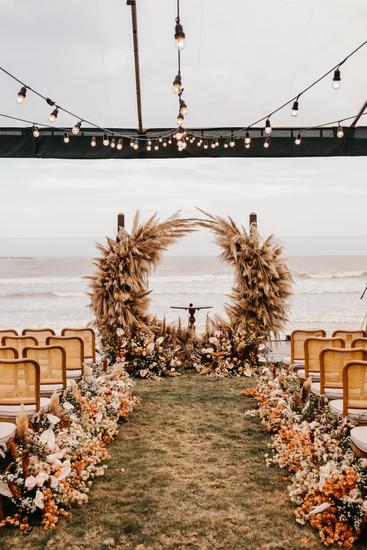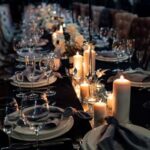Are you considering creating your own wedding dress? In this article, we will explore the benefits of taking on this unique DIY project. From cost savings to customization and sentimental value, making your own wedding dress can be a wonderful option for brides who want a truly personal and one-of-a-kind gown.
One of the most appealing aspects of making your own wedding dress is the potential for substantial cost savings. With the ever-increasing price tags on designer gowns, creating your own dress allows you to allocate your budget towards quality materials and personalized details rather than paying for a brand name. Additionally, choosing to make your own wedding dress offers the freedom to fully customize every aspect of the gown to perfectly suit your individual style, body type, and preferences.
Another compelling reason to consider making your own wedding dress is the sentimental value that comes with crafting such an important garment by hand. Not only does this process provide an opportunity for cherished memories and meaningful experiences, but it also allows you to infuse your love and personality into every stitch.
Throughout this article, we will guide you through each step of the wedding dress-making process, inspiring you to embrace the DIY approach and reap the rewards of creating a gown that truly reflects who you are as a bride.
Choosing the Right Fabric and Style for Your Dress
When embarking on the journey of making your own wedding dress, one of the most crucial decisions you’ll face is selecting the perfect fabric and style. The fabric you choose will not only determine the overall look and feel of your dress but also impact its comfort and ease of wear on your special day. Here are some essential tips for choosing the right fabric and style for your DIY wedding dress:
- Consider Your Body Type: Before choosing a fabric or style, it’s important to understand what flatters your body type. For example, if you have a pear-shaped figure, fabrics like chiffon or tulle can help create a balanced silhouette. On the other hand, if you have an hourglass figure, satin or silk may accentuate your curves beautifully.
- Explore Different Fabrics: There are countless options when it comes to wedding dress fabrics, from classic choices like lace and silk to more unconventional options such as crepe or organza. Each fabric has its unique characteristics, so consider factors such as drape, weight, and texture when making your selection.
- Get Inspired: Look for inspiration from bridal magazines, online resources, or even by visiting bridal boutiques to get an idea of different dress styles and silhouettes that appeal to you. Whether you prefer a sleek mermaid gown or a romantic ballgown with layers of tulle, understanding various styles can help narrow down your choices.
As you embark on this exciting project, remember that every decision you make in choosing the right fabric and style for your wedding dress will contribute to creating a garment that perfectly reflects your personal taste and vision for your special day.
Gathering Supplies and Equipment
When it comes to making your own wedding dress, gathering the necessary supplies and equipment is a crucial step in the process. Having the right materials and tools on hand will ensure that you can bring your vision to life and create a beautiful gown that reflects your personal style. Here are some tips for gathering everything you need to make your own wedding dress.
A Comprehensive List of Materials
Before you begin making your wedding dress, it’s important to have a comprehensive list of materials at your disposal. This includes the fabric for the dress itself, lining fabric, interfacing, boning (if needed), zippers or buttons, thread, and any other notions such as hooks, eye closures, or decorative elements. It’s also essential to have the right sewing machine needles and other sewing supplies like pins, shears, and a tape measure.
Where to Purchase Quality Fabric and Supplies
When it comes to selecting fabric and supplies for your wedding dress, it’s important to choose high-quality materials that will result in a beautiful finished product. Many bridal shops offer a variety of fabrics suitable for wedding gowns, including silk satin, lace, tulle, chiffon, and organza. Additionally, specialty fabric stores may carry a wider selection of luxury fabrics perfect for creating an elegant bridal gown.
Investing in Proper Equipment
In addition to gathering materials, investing in proper equipment is essential for making your own wedding dress. This includes having a reliable sewing machine capable of handling delicate fabrics like silk or lace. It may also be helpful to have specialized sewing tools such as a dress form or tailor’s ham for pressing curved seams. By having the right equipment on hand, you’ll be well-prepared to tackle the construction of your dream wedding dress.
Creating a Custom Design and Pattern
Designing and creating your own wedding dress can be an incredibly fulfilling and personal experience. One of the most important steps in this process is to develop a custom design and pattern that perfectly reflects your individual style and vision for your wedding day attire. Whether you have prior sewing experience or are taking on this project as a beginner, there are several key considerations to keep in mind when creating a custom design and pattern for your wedding dress.
Before diving into the design process, it’s essential to gather inspiration from various sources such as bridal magazines, fashion websites, and even vintage wedding dresses. Look for elements that resonate with you, whether it’s a specific neckline, sleeve style, or overall silhouette. By carefully examining different design details, you can start to envision the type of dress that you want to create.
Once you have a clear vision in mind, it’s time to develop a customized pattern for your wedding dress. If you have experience in pattern-making or are comfortable working with complex garments, you may choose to draft the pattern yourself.
However, if this is uncharted territory for you, seeking assistance from a professional seamstress or pattern-maker may be beneficial. They can help translate your design concepts into an accurate pattern that will serve as the foundation for constructing your wedding dress.
Finally, remember to stay open-minded throughout this creative process. It’s possible that the final design of your dress will evolve during the pattern-making phase based on practical considerations such as fabric choices and construction techniques. Embracing flexibility while remaining true to your original vision will ensure that your DIY wedding dress project is both enjoyable and successful.
| Benefits | Considerations |
|---|---|
| Reflects individual style | Stay open-minded throughout the creative process |
| Creative freedom | Gather inspiration from various sources |
| Opportunity for personalization | Seek assistance from professional if needed |
Sewing Techniques and Tips for Beginners
Whether you have some sewing experience or are a complete beginner, creating your own wedding dress is an ambitious project that requires some basic sewing skills. Before diving into the process of making your own wedding dress, it’s important to familiarize yourself with fundamental sewing techniques.
First and foremost, mastering straight and zigzag stitches is essential for constructing the main structure of your wedding gown. These stitches will be used for seaming, hemming, and attaching various components of the dress. Understanding how to operate a sewing machine and achieving consistent stitch length and tension are also crucial skills that every beginner should strive to perfect. If you’re new to using a sewing machine, consider practicing on scrap fabric before working on your actual wedding dress.
In addition to machine sewing, being comfortable with hand-sewing techniques can greatly benefit the overall construction of your wedding dress. Basic hand-stitches such as basting, backstitching, and slip stitching will come in handy for attaching delicate embellishments or finishing details with precision. These techniques allow for greater control and attention to detail in areas where the sewing machine may not be suited.
Lastly, understanding how to read and interpret patterns is an important aspect of executing any sewing project, especially a custom-made wedding dress. Even if you’re planning on creating your own original design, having knowledge of how commercial patterns are laid out and follow instructions can provide valuable insight into garment construction. Additionally, familiarizing yourself with pattern markings and symbols will help you accurately translate your design vision onto paper.
Now that we’ve covered the essential sewing techniques for beginners, it’s time to practice these skills as you move forward in the process of making your very own wedding dress. With patience, perseverance, and dedication to learning new sewing skills, you’ll soon be on your way to creating a stunning gown that reflects your unique style and personality.
Embellishments, Beading, and Lace Work
When making your own wedding dress, adding embellishments, beading, and lace can take your gown to the next level of elegance and sophistication. These delicate details can elevate a simple dress into a work of art and add a touch of personalization that reflects your unique style and taste. Whether you prefer subtle and romantic lace or sparkling beadwork, there are endless possibilities to consider when it comes to embellishing your handmade gown.
Ideas for Adding Embellishments
Before you begin embellishing your wedding dress, it’s important to have a clear vision of the look you want to achieve. Consider if you want intricate beading throughout the bodice, delicate lace appliques on the skirt, or subtle embellishments on the neckline. Look for inspiration in bridal magazines, online wedding dress galleries, and even vintage gowns for ideas that resonate with your aesthetic.
Tutorials for Creating Delicate Lace Details and Intricate Beadwork
If you’re new to working with lace and beadwork, there are many tutorials available that can guide you through the process. From sewing on lace appliques to hand-stitching intricate bead designs, these resources can provide valuable tips and techniques for achieving professional-looking results. Additionally, consider reaching out to local craft stores or bridal boutiques for workshops or classes on lace work and beading to refine your skills.
Selecting the Right Embellishments
When choosing embellishments for your wedding dress, it’s essential to select high-quality materials that will enhance the overall aesthetic of the gown. Opt for beads with luster and shine that complement the fabric of your dress, and select lace that is both durable and has an ethereal quality. By investing in premium embellishments, you can ensure that your handmade wedding dress exudes luxury and timeless beauty.
By taking your time with each embellishment detail and infusing love into every stitch, you can create a one-of-a-kind masterpiece that will hold sentimental value for years to come. Through creativity and patience, adding exquisite details such as beading, embroidery or lace will result in a wedding gown that truly stands out on this special day.
Fitting and Alterations
Creating a wedding dress that fits you perfectly is one of the most important aspects of making your own gown. Regardless of whether you are an experienced seamstress or a beginner, achieving the ideal fit for your wedding dress requires careful attention to detail and precise alterations. The first step in this process is to take accurate measurements of your body, ensuring that your dress will be tailored to your unique shape.
Once you have completed the construction of your wedding dress, it is essential to schedule fittings and adjustments with a professional seamstress or tailor. They can provide valuable expertise in altering the dress to ensure it fits comfortably and flatters your figure. It is important to communicate openly with the seamstress about any concerns or preferences you have regarding the fit of the dress.
Another vital aspect of fitting and alterations is addressing any potential issues with the dress, such as uneven hems, tightness in certain areas, or gaping at the bustline. Making these adjustments will guarantee that your handmade wedding dress looks and feels perfect on your special day. Keep in mind that alterations may require additional time and resources, so it’s advisable to begin this process well in advance of the wedding date.
Incorporating fitting and alterations into the process of making your own wedding dress will not only help you achieve a flawless fit but also allow you to personalize each detail according to your preferences. By embracing this DIY approach, you can create a gown that reflects your individual style and ensures that you feel confident and beautiful on your wedding day.
Finishing Touches and Personalization
Once you have completed the sewing and fitting of your wedding dress, it’s time to add those finishing touches and personalization that will truly make it your own. Whether it’s adding delicate embellishments or incorporating sentimental elements, this final step can elevate your handmade creation to a one-of-a-kind masterpiece. Here are some suggestions for adding those personal touches:
- Monogramming: Consider adding your initials, wedding date, or a special message embroidered onto the inside of your dress for a personal touch that is hidden but meaningful.
- Incorporating heirloom elements: If you have a piece of lace from your mother’s wedding gown or a special trinket from a loved one, consider incorporating these into your dress as a way to honor family traditions and create a heartfelt connection to the past.
- Handmade accessories: Create matching accessories such as a veil, sash, or bolero jacket that complement your dress and showcase your craftsmanship.
With these final details added, you can take pride in knowing that every aspect of your wedding dress has been carefully considered and crafted with love. Personalizing your dress in these ways will not only make it unique to you but will also create cherished memories for years to come.
If you’re wondering how to make your own wedding dress truly stand out, don’t be afraid to get creative with the finishing touches. After all, this is an opportunity to infuse a piece of yourself into the most important garment you’ll ever wear. Enjoy this last step in creating a wedding dress that reflects not only your style and personality but also the love and care that went into making it by hand.
Conclusion
In conclusion, making your own wedding dress can truly be a rewarding and fulfilling experience. Not only does it offer significant cost savings, but it also allows for a level of customization and personalization that is unmatched by store-bought dresses. By choosing the right fabric and style, gathering the necessary supplies, and mastering sewing techniques, you can create a dress that perfectly reflects your individuality and style.
Through the process of creating a custom design and pattern, adding embellishments and lace work, and ensuring the perfect fit through alterations, you have the opportunity to pour your heart and soul into every detail of your wedding dress. The final touches and personalization options give you the chance to make your dress truly unique to you as a bride.
Ultimately, embracing the DIY approach to your wedding dress not only allows you to save money but also gives you the satisfaction of wearing something that was lovingly crafted by your own hands. It may take time and effort, but in the end, the sense of accomplishment will be immensely gratifying. So if you’re willing to put in the work, making your own wedding dress can be a wonderful way to add personal significance to your special day.
Frequently Asked Questions
How to Make a DIY Wedding Dress?
Making a DIY wedding dress can be an ambitious and rewarding project for those with sewing skills. It typically involves selecting a pattern, choosing fabric, taking measurements, cutting and sewing the pieces together, and adding any desired embellishments. It requires attention to detail and patience, as well as time for fittings and adjustments.
Is It Cheaper to Make a Wedding Dress or Buy One?
Whether it is cheaper to make a wedding dress or buy one depends on various factors such as the cost of materials, the complexity of the design, and one’s own sewing skills. In some cases, making a wedding dress can be more cost-effective, especially if one already has the necessary skills and tools.
However, for others, buying a ready-made dress might be more affordable.
Is It Easy to Make Your Own Dress?
Making your own dress can be both challenging and rewarding. While simple designs may be relatively easy for those with some sewing experience, more complex styles can require advanced skills and techniques.
The process involves careful measurements, precision cutting and stitching, as well as knowledge of garment construction. With practice and dedication, creating your own dress can be a fulfilling endeavor.

I have been involved in marriages for over 20 years helping couples and singles understand more about them.





